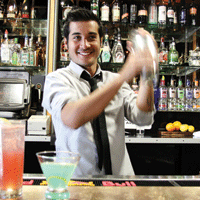Mixologists are breaking stereotypes and concocting bold recipes that elevate their craft. F&H spoke with three such trendsetters, from east to west
Katrina Roberts
Mixologists are inspired by their surroundings, so when Katrina Roberts, wine and beverage director at Halifax’s Morris East restaurant, saw a wood-burning oven, she used it to make wood-fired date syrup for her cocktails.
Surprisingly, the 30-year-old Halifax native didn’t always have aspirations to work in foodservice. She studied opera at McGill University before being lured to the restaurant scene by a fellow opera singer. “I was like a little sponge,” she says, explaining how she watched bartenders mix drinks and was self-taught. At 19, she moved to Cardiff, Wales and worked at Pica Pica, where the Welsh customer base enjoyed her fresh, herb-infused bevvies.
Moving back home to Halifax, Roberts brought her passion for fresh herbs to Morris East, where she has led the cocktail program for the past three years. “I found we had great access to Riverview Herbs, which is just in the valley here, so I started using a lot of basil, thyme and sage, and I make my own syrups to ensure the freshness of it,” she explains. Local cherries are her guaranteed go-to for adding a uniquely provincial flair to any drink. “We have great sour cherries growing here in Nova Scotia,” she explains.
The Halifax cocktail scene is growing from a predominantly beer-drinking city to one that appreciates the finer cocktail. “You are already seeing people here doing beer cocktails,” she explains. Food and cocktail pairings are also gaining popularity, and she often creates a special drink to complement the restaurant’s nightly food special. “I had a drink that I made in the past week; it was with elderflower, gin and rosemary cordial with sparkling wine,” which might pair with our salad that’s made with rosemary.
For Roberts, success can be measured by finding a drink that fits any customer’s needs. And, with a customer base that’s showing a budding curiosity in mixology, it’s fun to appeal to their tastebuds. “It’s where things really start to get exciting, because people are willing to try more things and grow that education — that’s when we can do anything we want.”
Simon Ho
To Simon Ho, bartender at Toronto’s Drake Hotel, every cocktail idea starts with the question, ‘what can I sit and drink for hours on a patio?’ It’s this thinking that’s spawned countless summer-inspired cocktail combinations during his tenure at the popular Queen West hotspot.
The 27-year-old doesn’t like to call himself a “mixologist,” even after working through the ranks at The Drake, starting out as a busboy then learning the basics of bartending. He started winning Iron-Chef-style cocktail competitions and making a name for himself in the city, including showcasing his whimsical recipes on CBC’s Steven and Chris talk show. These days, he can be found whipping up drinks on the Drake’s rooftop Sky Yard patio or behind the bar at a dance party at the hotel’s “Underground” performance venue. “I have a big personality, so the kitchen wasn’t really an option for me,” says the bartender, who names his cocktails after ’90s hip-hop songs (such as “Welcome to the Tarragon”) and admittedly doesn’t take himself too seriously.
He is serious about his recipes. “I like using Asian flavours, because I am half-Chinese,” he says, explaining that he infuses drinks with lemongrass, Asian green teas and ginger. And he’s in the perfect venue to keep innovating behind the bar, with The Drake’s recurring pop-up themes, such as the old Chinatown menu focus from last fall. “It gave me a way to use Asian flavours like [our executive chef] Anthony Rose did with the menu that was Asian-inspired but not necessarily traditional Asian,” he says.
Young talent is especially important in a city that, is “still struggling to figure out what it is,” he says. Toronto bars serve cocktails with a classic approach and a lot of spirit-straight cocktails, but bitters and ice programs are fast emerging on the scene, he explains, adding the biggest challenge is the consumer. “Not that it’s not educated,” he explains, “but it’s just that it hasn’t had the history — you go to New York and there’s been speakeasys and cocktail bars for years … so the consumer market is much bigger and the palates have adjusted.”
Ho calls himself an “ambassador of good times.” Mixology is a small but important part of being a good bartender, he adds. “I’m in the business of providing an experience.”
Lauren Mote
Ask Lauren Mote, co-owner of Kale & Nori Culinary Arts, what’s the hardest part about manning a bar, and she’ll tell you it’s not the long hours, or the pressure to stay on top of trends, it’s back pain from staying on her feet all day. “There is literally no other problem with being a bartender,” she laughs.
Mote has come a long way in the 12 years since she started out fresh-faced at Wayne Gretzky’s Toronto, where she learned the basics of hospitality and speed of service, before moving to Vancouver in 2007 and taking a bar manager job at Lumière. She moved through the ranks at Goldfish Pacific Kitchen and Chow Restaurant, before landing at The Refinery where she spent three years as the restaurant’s GM, rebranding the concept and beverage focus to serve completely homemade ingredients and “probably the largest bitters program in Canada,” with 240 unique cocktail recipes.
And, the 30-year-old added entrepreneur to her résumé when she launched Kale & Nori Culinary Arts — a boutique restaurant-style catering and events company with a retail line of bitters — with her partner, Jonathan Chovancek. “It’s amplified on seasonal and local, and it’s focused on avant-garde beverage,” she says.
Many mixologists develop their own style, but Mote maintains hers is relatively fluid. “It’s always ever-changing, it’s always creativity-driven, and it’s always innovative” without being gimmicky, she explains. The key is to forego a pre-planned menu, shop for seasonal ingredients and let each component shine. “In a cocktail that would only require four or five ingredients … I’m not going to use 10 ingredients — it’s just that each ingredient that goes in has to be a complete amplified expression of whatever the ingredient is called,” she explains.
After a day of mixing drinks for clients, events and judging competitions, Mote refuses to succumb to the bartender stereotype perpetuated by Hollywood. Instead, she prefers “being healthy, working out, eating well and not living the quintessential bartender lifestyle.”
Keep Reading
Golden Opportunity: California Wines
Hot Concept: Frozen is the New Hot




















